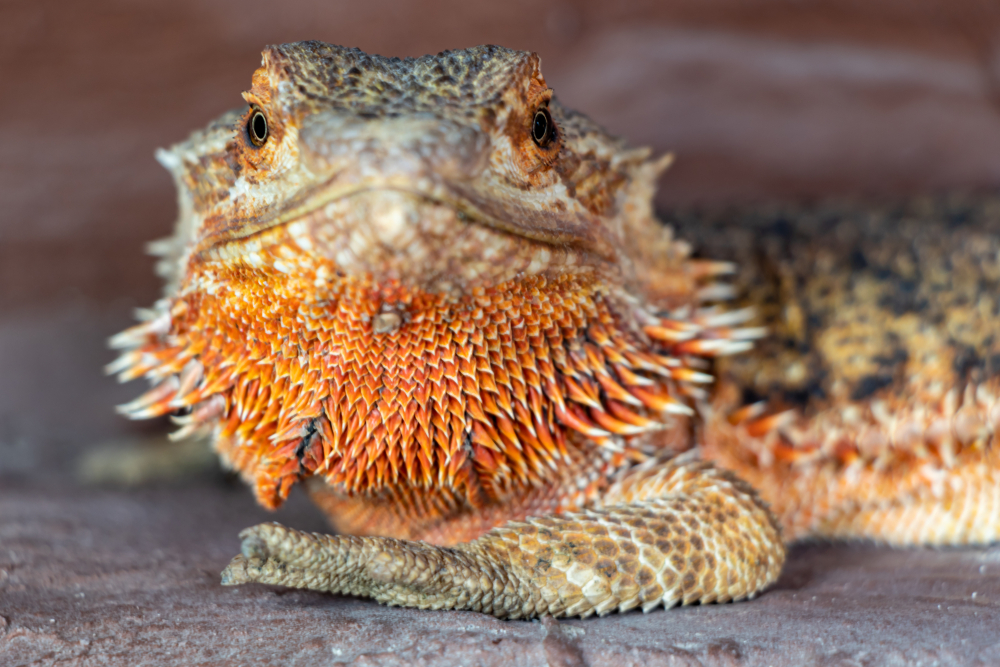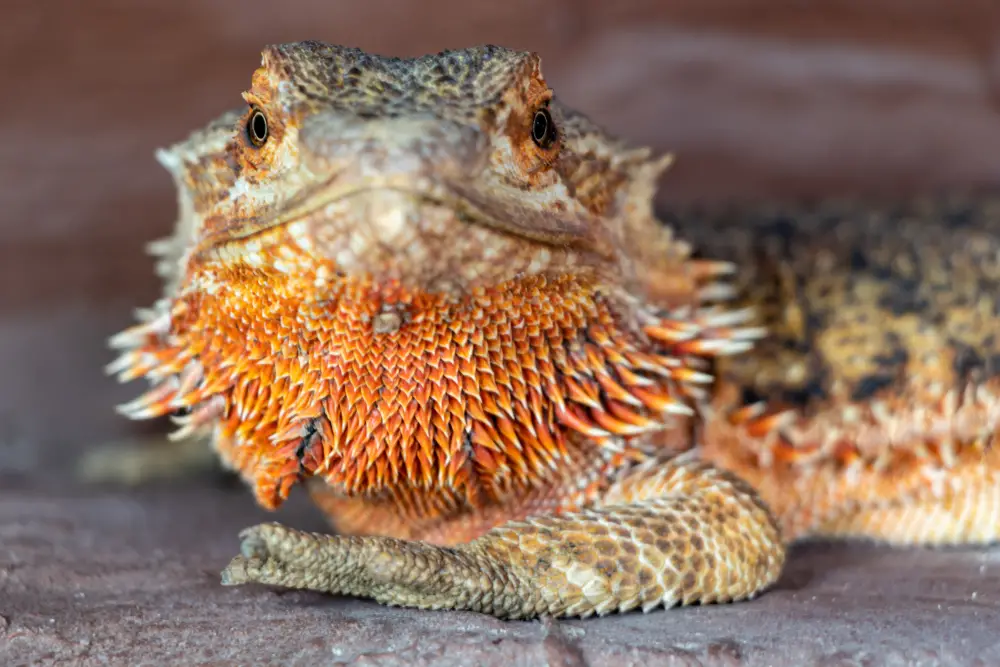Bearded dragons are fascinating creatures with unique characteristics that make them stand out from other reptiles. One of their most intriguing features is the third eye located on the top of their head. But can you touch it?
In this article, we will explore the function of a bearded dragon’s third eye and whether it’s safe to touch. We will also delve into the anatomy of this unusual organ and how it helps these lizards navigate their surroundings. So, let’s get ready to dive into the world of the bearded dragon and discover the secrets of its third eye.
Yes, you can touch a bearded dragon’s third eye, which is located on the top of its head. It’s also known as a parietal eye and is used to detect light and dark. However, it’s sensitive and should be touched gently. Avoid touching it too often, as it may cause stress to your pet bearded dragon.

Can You Touch a Bearded Dragon’s Third Eye?
Bearded dragons are fascinating creatures that have become increasingly popular as pets in recent years. They are known for their docile nature, unique appearance, and interesting behaviors. One of the most intriguing aspects of bearded dragons is their third eye, also known as the parietal eye. But can you touch a bearded dragon’s third eye? Let’s explore this topic in more detail.
What is a Bearded Dragon’s Third Eye?
A bearded dragon’s third eye is located on the top of its head and is visible as a small, circular area between its two regular eyes. This eye is not like the other two eyes, as it does not have a lens, and it cannot see images. Instead, the third eye is sensitive to light and dark, and it helps the bearded dragon regulate its circadian rhythm, which is the internal clock that tells the animal when it’s time to sleep and wake up.
Can You Touch a Bearded Dragon’s Third Eye?
As a pet owner, it’s natural to want to touch and interact with your bearded dragon as much as possible. However, when it comes to the third eye, it’s best to leave it alone. The third eye is a sensitive organ, and touching it can cause the bearded dragon to become stressed and agitated. In some cases, touching the third eye can even lead to health issues, such as eye infections or damage to the brain.
Benefits of the Third Eye for Bearded Dragons
While it’s not recommended to touch a bearded dragon’s third eye, it’s important to understand the role it plays in the animal’s overall health and well-being. The third eye helps bearded dragons regulate their circadian rhythm, which is essential for their overall health. It also helps them detect changes in light and dark, which can signal potential danger or prey.
Other Interesting Facts About Bearded Dragons’ Third Eye
– The third eye is unique to reptiles, and bearded dragons are one of the few species that have a visible third eye.
– The third eye is connected to the pineal gland, which is responsible for producing melatonin, a hormone that regulates sleep.
– Bearded dragons can use their third eye to differentiate between different wavelengths of light, which is important for detecting predators or prey.
– The third eye can also help bearded dragons navigate through their environment, especially in low-light conditions.
Conclusion
In conclusion, while the third eye of a bearded dragon is fascinating, it’s best to leave it alone. Touching the third eye can cause stress and health issues for the animal. Instead, focus on providing your bearded dragon with a comfortable and healthy environment that allows it to thrive. By understanding the role of the third eye in your pet’s overall health and well-being, you can become a better and more responsible pet owner.
Frequently Asked Questions:
Bearded dragons are popular pets among reptile enthusiasts. They are known for their unique appearance and gentle nature. However, there are some misconceptions about bearded dragons, particularly when it comes to their third eye. Here are five frequently asked questions about touching a bearded dragon’s third eye:
Can you touch a bearded dragon’s third eye?
Yes, you can touch a bearded dragon’s third eye. The third eye, also known as the parietal eye, is located on the top of the head between the two regular eyes. It is sensitive to light and can detect changes in brightness and darkness. It also plays a role in regulating the bearded dragon’s circadian rhythm. Some bearded dragon owners believe that gently stroking the third eye can help calm their pet. However, it is important to be gentle and avoid putting too much pressure on the area.
While touching a bearded dragon’s third eye is generally safe, it is important to note that not all bearded dragons may enjoy it. Some may be more sensitive than others, and some may not like being touched on the top of their head. Always watch for signs of discomfort or stress, such as hissing, biting, or trying to escape. If your bearded dragon seems uncomfortable, stop touching their third eye and try a different form of interaction.
What is the purpose of a bearded dragon’s third eye?
The third eye on a bearded dragon serves a few different purposes. First and foremost, it helps the bearded dragon detect changes in light and dark, which is important for regulating their circadian rhythm. This helps them know when it is time to wake up, eat, and sleep. Additionally, the third eye can also help the bearded dragon navigate their environment. It is sensitive to movement and can detect predators or other threats. Finally, some bearded dragon owners believe that gently stroking the third eye can help calm their pet.
While the third eye is an important part of a bearded dragon’s anatomy, it is not essential for their survival. Some bearded dragons may not develop a third eye at all, while others may have one that is smaller or less functional. As long as the bearded dragon is otherwise healthy and happy, the absence or presence of a third eye should not be a cause for concern.
Is it safe to touch a bearded dragon’s third eye?
Touching a bearded dragon’s third eye is generally safe, as long as you are gentle and do not put too much pressure on the area. The third eye is sensitive to light and touch, so it is important to be careful when handling your pet. Some bearded dragon owners believe that gently stroking the third eye can help calm their pet, but it is important to watch for signs of discomfort or stress. If your bearded dragon seems uncomfortable, stop touching their third eye and try a different form of interaction.
It is also important to note that not all bearded dragons may enjoy being touched on the top of their head. Some may be more sensitive than others, and some may not like being handled in this way. Always watch for signs of discomfort or stress, such as hissing, biting, or trying to escape. If your bearded dragon seems uncomfortable, respect their boundaries and try a different way of interacting with them.
What happens if you touch a bearded dragon’s third eye?
If you touch a bearded dragon’s third eye, it is unlikely that any harm will come to your pet. The third eye is sensitive to light and touch, so your bearded dragon may react by blinking or turning their head away. However, some bearded dragons may enjoy being touched on the top of their head, and may even close their eyes or lean into your touch.
While touching a bearded dragon’s third eye is generally safe, it is important to be gentle and avoid putting too much pressure on the area. Some bearded dragons may be more sensitive than others, and may not enjoy being touched in this way. Always watch for signs of discomfort or stress, such as hissing, biting, or trying to escape. If your bearded dragon seems uncomfortable, stop touching their third eye and try a different form of interaction.
How do you know if a bearded dragon likes being touched on the third eye?
There is no surefire way to know if a bearded dragon likes being touched on the third eye, as each pet is unique in their preferences and personality. However, there are some signs that may indicate that your bearded dragon is enjoying the interaction. For example, they may close their eyes, lean into your touch, or remain still and relaxed. They may also show signs of enjoyment, such as bobbing their head or puffing out their beard.
However, it is important to remember that not all bearded dragons may enjoy being touched on the third eye. Some may be more sensitive than others, and some may not like being handled in this way. Always watch for signs of discomfort or stress, such as hissing, biting, or trying to escape. If your bearded dragon seems uncomfortable, respect their boundaries and try a different way of interacting with them.
Does Bearded Dragon Have A Third Eye? | GrimDragons.com
In conclusion, touching a bearded dragon’s third eye is not recommended as it can cause discomfort and stress for the reptile. It is important to handle these animals with care and respect, as they are living creatures with their own unique needs and behaviors.
Instead of touching their third eye, bearded dragons can be interacted with in other ways such as providing appropriate habitats, feeding them a balanced diet, and spending time with them in a calm and gentle manner. These actions can strengthen the bond between the pet and owner while also promoting the overall well-being of the animal.
Overall, it is important for pet owners to educate themselves about the proper care and handling of their pets, including bearded dragons. With proper care and attention, these fascinating creatures can thrive and bring joy to their owners for years to come.


